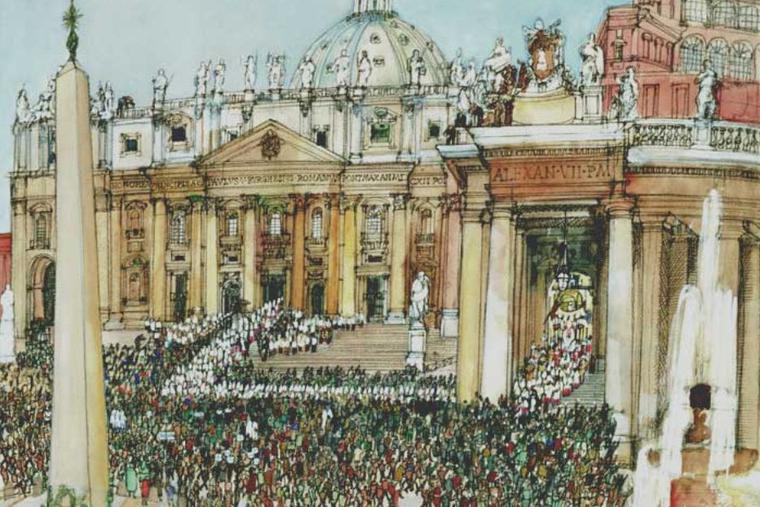Vatican II at 60: Reading List to Understand the Council
For those interested in digging deeper into the riches of the Second Vatican Council, two Catholic commentators offer thoughts on the trove of books available on Vatican II.

Editor's Note: Alan Schreck is a professor of theology at Franciscan University of Steubenville whose specialties include the teachings of the Second Vatican Council and Pope St. John Paul II. His many books include Vatican II: The Crisis and the Promise.
The Documents of Vatican II
There is no substitute for reading all 16 official documents of the Second Vatican Council. Church historian James Hitchcock wrote that these “remain among the great unread documents of modern times” (Catholicism and Modernity, 223). He observes that while practically everyone has an impression of what Vatican II taught, “few demonstrate an intimate familiarity with its actually statements.”
This is tragic, because the Holy Spirit guided what the Council Fathers actually wrote in these documents. Don’t be put off by the apparent length of the books containing these documents. Most print publications include commentaries or other post-conciliar documents, not necessary for most readers. And the vocabulary of the documents is generally accessible to the average reader. You don’t need a theological dictionary to understand them, but keep a Bible handy to refer to the numerous texts cited.
‘Readers’ Guides’ to the Documents
These may be helpful for the average reader, but some that present “keys” to the Council or “essential texts” omit important points or even some documents of the Council. They may highlight what are the new emphases or perspectives of the Council’s teachings (such as its approach to other Christians or non-Christian religions), while neglecting other points (such as the necessity of missions and evangelization, as was pointed out in Ralph Martin’s Will Many Be Saved?: What Vatican II Actually Teaches and Its Implications for the New Evangelization, Eerdmans, 2012). I seek to present a balanced overview in my book, Vatican II: The Crisis and the Promise (Franciscan Media, 2005). Edward Hannenberg’s A Concise Guide to the Documents of Vatican II (Franciscan Media, 2007) includes some of the background to the formulation of the documents at the Council.
History of the Council
A beautifully illustrated, fact-filled (but “pricey”) book is Vatican II: The Complete History from the John XXIII Foundation for Religious Studies at Bologna, directed by Alberto Melloni (Paulist Press, 2015). John W. O’Malley’s What Happened at Vatican II (Belknap/Harvard University Press, 2008) is the best short history of the Council. For a comprehensive scholarly history, there is the five-volume History of Vatican II, Guiseppe Alberigo, ed./Joseph A. Komonchak, English edition (Orbis/Peeters, 1995-2006).
Interpretations/Essays
There are a plethora of books and collections of essays interpreting the Council. Herbert Vorgimler edited a five-volume Commentary on the Documents of Vatican II soon after the Council (Herder and Herder, 1966-68). One of the earliest short commentaries was then-Cardinal Karol Wojtyla’s Sources of Renewal: The Implementation of Vatican II (1972, English Edition Harper & Row, 1979). Some books by single authors are Massimo Faggioli’s Vatican II: The Battle for Meaning (Paulist, 2012) and Ormond Rush’s The Vision of Vatican II: Its Fundamental Principles (Liturgical Press, 2019) which is comprehensive (550+ pages).
There are many collections of essays on the Council. I like an early collection edited by Anthony J. Cernera Vatican II: The Continuing Agenda (Sacred Heart University Press, 1997) and, more recently, Vatican II: Renewal Within Tradition, edited by Matthew L. Lamb and Matthew Levering (Oxford University Press, 2008).
Final Thought
Once again, there is no substitute for reading the Council documents, beginning with the four constitutions: Sacrosanctum Concilium, Dei Verbum, Lumen Gentium and Gaudium et Spes. Read them prayerfully in small sections, a paragraph or two at a time — a contemporary lectio divina!
Alan Schreck, Ph.D., is professor emeritus of theology at Franciscan University of Steubenville.
Teresa Tomeo’s Pick
As my husband and I were making our way back into full communion with the Church, we had what seemed like countless “V8” moments, so to speak. Many folks might remember that old vegetable-juice commercial, which had folks proclaiming after eating or drinking something unhealthy, “Wow, I could have had a V8!” That’s how we felt, once we began reading and studying Church documents, including the documents of Vatican II. Where were we all those years away from the Church, taking in all that cultural junk food, and why didn’t we know about all the incredible writings readily available at our fingertips?
That’s why I highly recommend, The Word on Fire Vatican II Collection, from Word on Fire ministries. Not only is it a one-stop-shopping resource containing the four major Vatican II documents, including Dei Verbum, Lumen Gentium, Sacrosanctum Concilium and Gaudium et Spes, this books also offers great commentary and reflection from much-loved Catholic teacher and philosopher Bishop Robert Barron, as well as words of wisdom from Pope St. John Paul II and Pope St. John XXIII, not to mention the closing Vatican II address of Pope St. Paul VI, at your direct disposal. It’s a win-win.
Journalist Teresa Tomeo is host of EWTN Radio’s Catholic Connection and EWTN TV’s The Catholic View for Women.
- Keywords:
- vatican ii
- reading
- teresa tomeo
















